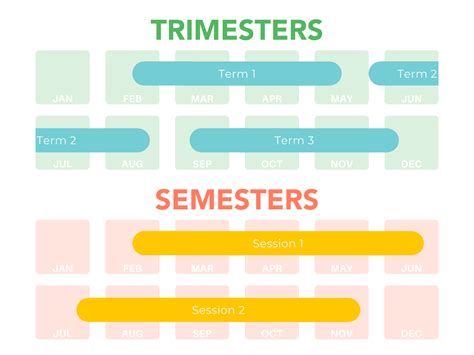When it comes to choosing a college or university, one of the key decisions you’ll need to make is whether to attend a semester-based or trimester-based school. Both systems have their own advantages and disadvantages, so it’s important to weigh the pros and cons carefully before making a decision.

Semester System
In a semester system, the academic year is divided into two semesters, each of which lasts for about 15 weeks. Classes typically meet once or twice per week for 50-75 minutes. Students typically take 4-5 courses per semester, and they have a break of about two weeks between each semester.
Pros of the Semester System:
- More time for studying: With only 4-5 courses per semester, students have more time to focus on each subject and develop a deeper understanding of the material.
- More flexibility: Students can choose to take a variety of courses each semester, and they can drop or add courses without penalty during the first few weeks of the semester.
- More breaks: The two-week break between semesters gives students time to relax, catch up on their studies, or work.
Cons of the Semester System:
- More stress: With less time to complete each course, students may feel more stressed during the semester.
- Less time to explore interests: With a limited number of courses per semester, students may not have time to explore all of their interests.
- More difficult to make up for missed classes: If a student misses a class, they have less time to catch up on the material before the next class.
Trimester System
In a trimester system, the academic year is divided into three trimesters, each of which lasts for about 10 weeks. Classes typically meet two to three times per week for 50-75 minutes. Students typically take 3-4 courses per trimester, and they have a break of about one week between each trimester.
Pros of the Trimester System:
- More flexibility: With a shorter duration than semesters, trimesters allow students to take a wider variety of courses and complete their degree more quickly.
- Less stress: The shorter length of trimesters means that students have less time to complete each course, which can reduce stress levels.
- More time to focus on interests: With a limited number of courses per trimester, students have more time to explore their interests and take courses that may not be available in a semester system.
Cons of the Trimester System:
- Less time for studying: With only 3-4 courses per trimester, students have less time to focus on each subject and develop a deeper understanding of the material.
- Less time to make up for missed classes: If a student misses a class, they have less time to catch up on the material before the next class.
- More difficult to transition between different topics: The shorter length of trimesters means that students may have to transition between different topics more quickly, which can be more challenging.
Which System is Right for You?
The best way to decide which academic calendar is right for you is to consider your own learning style and preferences. If you prefer to have more time to study and develop a deeper understanding of the material, then a semester system may be a better choice for you. If you prefer to have more flexibility and the opportunity to explore your interests, then a trimester system may be a better choice for you.
Table 1: Comparison of Semester and Trimester Systems
| Characteristic | Semester System | Trimester System |
|---|---|---|
| Length of terms | About 15 weeks | About 10 weeks |
| Number of terms per year | 2 | 3 |
| Number of courses per term | 4-5 | 3-4 |
| Length of breaks between terms | About 2 weeks | About 1 week |
| Flexibility | More flexible | More flexible |
| Stress levels | More stressful | Less stressful |
| Ability to explore interests | Less time to explore interests | More time to explore interests |
| Ability to make up for missed classes | Less time to make up for missed classes | Less time to make up for missed classes |
Table 2: Pros and Cons of Semester and Trimester Systems
| System | Pros | Cons |
|---|---|---|
| Semester System | * More time for studying * More flexibility * More breaks | * More stress * Less time to explore interests * More difficult to make up for missed classes |
| Trimester System | * More flexibility * Less stress * More time to focus on interests | * Less time for studying * Less time to make up for missed classes * More difficult to transition between different topics |
Table 3: Examples of Colleges and Universities that Use Semester and Trimester Systems
| System | Colleges and Universities |
|---|---|
| Semester System | * Arizona State University * University of California, Berkeley * Harvard University * Ohio State University |
| Trimester System | * Colorado College * Cornell University * University of Chicago * Rice University |
Table 4: Average Tuition Costs for Semester and Trimester Systems
| System | Estimated Annual Tuition Costs (2023-2024) |
|---|---|
| Semester System | $25,000-$40,000 |
| Trimester System | $30,000-$45,000 |
Conclusion
Ultimately,
